Marketing Workflow Management: How to Prevent Last-Minute Emergencies
 How many times have you been disrupted by a last-minute project?
If you’re like most marketers, probably more times than you can count. Someone from another department has something they need done, and they haven't given you enough time. Their poor planning becomes your late night at the office, and no one goes home happy.
There has to be a better way, right?
The key is to stop last-minute emergencies before they start with an effective marketing workflow management process. By developing a clear list of marketing services your team can provide, along with detailed timelines, you can set ground rules for how others request your team’s time.
Implemented successfully, this type of process will:
How many times have you been disrupted by a last-minute project?
If you’re like most marketers, probably more times than you can count. Someone from another department has something they need done, and they haven't given you enough time. Their poor planning becomes your late night at the office, and no one goes home happy.
There has to be a better way, right?
The key is to stop last-minute emergencies before they start with an effective marketing workflow management process. By developing a clear list of marketing services your team can provide, along with detailed timelines, you can set ground rules for how others request your team’s time.
Implemented successfully, this type of process will:
- Eliminate last-minute headaches. Stop letting other people’s lack of foresight derail your own team's priorities.
- Enable your team to work more efficiently. When team members know exactly what they’ll do each day, they can prepare more effectively. That leads to more work getting done on time with less stress.
- Let you go home on time. Your family misses you.
Start By Developing a Marketing Services Catalog
Did you ever get the Toys R Us catalog when you were a kid? If you were like me, you probably spent hours circling things you were hoping to get for the holiday season. Your marketing services catalog is similar, except instead of gadgets and gizmos, it lists all the services other departments in your company can request from you. By presenting your services this way, you can make it clear to others what you can (and cannot) do. It also helps to set realistic expectations for when you can complete the work. Your catalog should include the following:- Your available services. These are the things you can do. For example, if your sales team needs sales collateral, they could choose “Presentation Slidedeck” or “One-Page Sales Sheet”.
- Time estimates. This is how long each type of project typically takes to complete.
- Point of contact. Who should people direct their requests to?
Marketing Workflow Management: How to Prevent Last-Minute Emergencies
Click To TweetList Your Available Services
Odds are your team can create a wide array of content assets. However, you probably have limits, too. Help the rest of your organization understand what you can (and can’t) do for them by listing out all your available services. Begin by figuring out:- Which types of content do you create most often? These are your bread and butter projects.
- Which types of content might your organization need? It might help to discuss this with stakeholders in your organization.
- Who is responsible for creating each type of content or executing each type of marketing project? This will be important information to have documented later on.
Determine Time Estimates For Each Service
When someone asks you to do something, you should be clear about how long it will take. Instead of relying on guesswork, develop a simple process for delivering accurate estimates. This will help you set clear expectations for every project. So, how exactly can you tell how long something will take before you even get started? The answer is by tracking time on past projects and using that data to make an estimated projection. Real-world completion times might vary, but this will help you get close. Start by building a simple spreadsheet (or use the free downloadable one included in this post’s template bundle). It should look something like this:- Timer Tab: free web-based timer and stop-watch.
- Stopwatch and Timer: Android timer app.
- Timer+: iOS timer app.
- Toggl: A robust time-tracking app for every platform imaginable.
Build Repeatable Workflow Checklists for Every Project and Task
If you have recurring projects you complete on a routine basis, build a checklist for each one. It’s a lot easier to get the work done thoroughly and consistently when you develop habits to tackle them quickly. With well-written checklists, you’ll eventually be able to work through tasks faster, without missing any important details. There are a few steps involved in doing this the right way. Let’s walk through them.Map Out Project Workflows and Timelines
Now that you’ve determined how long projects take for each team member, it’s time to bring that together and determine how long projects take in total. Begin by listing out each step involved in completing a given task, and who is responsible for each task: Then, determine how many days to leave for project handoffs (periods where one team member is done with their steps and passing it along to the next person). This should be based on the average number of hours it takes to complete each step (on average).
Then, determine how many days to leave for project handoffs (periods where one team member is done with their steps and passing it along to the next person). This should be based on the average number of hours it takes to complete each step (on average).
 This should give you an accurate picture of how long it takes your team to get something done. Be sure to include enough breathing room for any roadblocks or plan changes you might encounter. Ideally, you’ll be able to work ahead, so you’re not always working directly against a deadline.
This should give you an accurate picture of how long it takes your team to get something done. Be sure to include enough breathing room for any roadblocks or plan changes you might encounter. Ideally, you’ll be able to work ahead, so you’re not always working directly against a deadline.
Create Marketing Project Checklists
List the steps for each project included in your service catalog. Include the name of the team member responsible for each step, and note how many days each person has to complete their work. This helps remove ambiguity around who is doing what, and when they’re supposed to finish it. To make this easier, you can use the free checklist template we’ve included in your free template bundle. Here’s what it looks like: Again, this is an extremely simple template. However, laying out each step for every project (and doing each one in the most efficient order) can be powerful for building productive habits. Here’s a quick interview between Atul Gawande (author of The Checklist Manifesto) and WYNC covers the psychology behind this. He applies this principle to medicine, but it works for marketing, too:
Again, this is an extremely simple template. However, laying out each step for every project (and doing each one in the most efficient order) can be powerful for building productive habits. Here’s a quick interview between Atul Gawande (author of The Checklist Manifesto) and WYNC covers the psychology behind this. He applies this principle to medicine, but it works for marketing, too:
 Alternately, we’ve also included a printable checklist template you can use. Here’s what it looks like:
Alternately, we’ve also included a printable checklist template you can use. Here’s what it looks like:
 Use the one you prefer most.
CoSchedule customers can also build reusable checklists using Task Templates. They make it easy to create checklists, keeping track of your progress percentage toward goal each time you check off a completed task.
Use the one you prefer most.
CoSchedule customers can also build reusable checklists using Task Templates. They make it easy to create checklists, keeping track of your progress percentage toward goal each time you check off a completed task.

Build Your Marketing Services Catalog
Once you’ve built a full list of project types and time estimates, you’re ready to build your catalog. Use the free downloadable Marketing Service Catalog template included in this post to complete this next step. Find the following section in your template. Then, fill in the appropriate fields: Fill in the first line with the project category. Then, on the second line, add the specific project type. Below that, add in the amount of time that work should take to complete. If there is someone specific in your organization that should be contacted for that request, include their contact information, too.
Next, copy and paste this block of text as many times as you need to fill out all your available service categories and project types. Here's what it might start to look like once it's filled in:
Fill in the first line with the project category. Then, on the second line, add the specific project type. Below that, add in the amount of time that work should take to complete. If there is someone specific in your organization that should be contacted for that request, include their contact information, too.
Next, copy and paste this block of text as many times as you need to fill out all your available service categories and project types. Here's what it might start to look like once it's filled in:
 Once you've added all your available services, scroll up to the Table of Contents page (the second page in the template). Then, click Insert on the top tool bar, and drill into Index and Tables. Select your style format of choice, and click OK.
Once you've added all your available services, scroll up to the Table of Contents page (the second page in the template). Then, click Insert on the top tool bar, and drill into Index and Tables. Select your style format of choice, and click OK.
 This will auto-populate a clickable table of contents:
This will auto-populate a clickable table of contents:
 Next, we'll outline a process your organization can use to request projects and "bill" your time. Store your catalog on an intranet, distribute copies via email, or get it in your organization's hands the best way possible. That way, they'll have it on hand when they need your team's time.
Next, we'll outline a process your organization can use to request projects and "bill" your time. Store your catalog on an intranet, distribute copies via email, or get it in your organization's hands the best way possible. That way, they'll have it on hand when they need your team's time.
Develop A Time-Billing Process
Agency folks understand how billing time works. You track time for each team member on each project and bill your client accordingly per your hourly rates. In-house marketers creating collateral for other internal teams can apply a similar framework, too. Do this by giving other teams an hourly budget for your team members time. Each time they request a project, you can give them an hourly “cost,” and a timeline for completion. This can help you manage your time effectively and reduce pressure from last-minute requests.This process can help you manage your time effectively and reduce pressure from last-minute requests.
Click To Tweet- How much time per week can each team member apply to projects outside our own marketing department’s goals? Now that you’ve calculated how much time it takes for each person to complete different tasks, you can easily figure this out.
- How often do we receive outside requests? For example, if you know your sales team will need collateral from you every two weeks, and you know how long those pieces take to create, you can set aside an acceptable amount of time.
Set Up a Project Request Form
Next, you’ll need to set up a project request form for other teams to use. This is how they’ll ask for your team’s time to work on projects they need. Google Forms makes this easy. Follow along to build out the fields you’ll need. Step 1: Visit Google Forms and select Blank: Step 2: In the Title field, enter Marketing Project List. Then, under Description, enter “Complete this form to request a project from our marketing team.” Feel free to edit either of these as you like.
Step 2: In the Title field, enter Marketing Project List. Then, under Description, enter “Complete this form to request a project from our marketing team.” Feel free to edit either of these as you like.
 Step 3: List each type of marketing project someone can request. Keep adding more until you’ve listed everything available.
Step 3: List each type of marketing project someone can request. Keep adding more until you’ve listed everything available.
 Step 4: Click the slider to make this field required:
Step 4: Click the slider to make this field required:
 Step 5: Click the plus sign to add another question.
Step 5: Click the plus sign to add another question.
 Step 6: From the drop-down menu, select Short Answer.
Step 6: From the drop-down menu, select Short Answer.
 Step 7: Fill in the question text. Something to the effect of “When does this need to be done?” will work.
Step 7: Fill in the question text. Something to the effect of “When does this need to be done?” will work.
 Step 8: Keep adding more questions as necessary. You might also want to include project notes, contact information, or anything else that might help in your specific situation. As you proceed, drag the questions into the correct order by clicking and dragging on the six dots you see pictured:
Step 8: Keep adding more questions as necessary. You might also want to include project notes, contact information, or anything else that might help in your specific situation. As you proceed, drag the questions into the correct order by clicking and dragging on the six dots you see pictured:
 Step 9: Add one more short answer question for name and department.
Step 9: Add one more short answer question for name and department.
 Step 10: Next, click the Settings gear icon in the upper right, and restrict the form to people within your company (if you’re using G Suites).
Step 10: Next, click the Settings gear icon in the upper right, and restrict the form to people within your company (if you’re using G Suites).
 Step 11: Decide who will be responsible for managing the flow of incoming project requests. This should be a project manager, department head, or other senior-level staffers.
Step 12: Click Send. Then, click the link icon. Copy and paste that link into your browser.
Step 11: Decide who will be responsible for managing the flow of incoming project requests. This should be a project manager, department head, or other senior-level staffers.
Step 12: Click Send. Then, click the link icon. Copy and paste that link into your browser.
 Step 13: You’ll now see your form live. Look it over and make sure it’s good to go.
Step 13: You’ll now see your form live. Look it over and make sure it’s good to go.
 Step 14: Make the link to your form available to your organization. Here are a couple of options:
Step 14: Make the link to your form available to your organization. Here are a couple of options:
- Send the link to everyone in the company and ask them to bookmark it.
- Include a link in any centralized project management, communication tool, or intranet you might use. You can embed forms too by clicking Send, then clicking < >:

 To see more detail, click over to the Individual tab:
To see more detail, click over to the Individual tab:
 Now, you can see exactly what is being requested.
Step 16: Go back to the Responses page, and click Make Spreadsheet.
Now, you can see exactly what is being requested.
Step 16: Go back to the Responses page, and click Make Spreadsheet.
 This will create a Google Sheet that includes all your responses:
This will create a Google Sheet that includes all your responses:
 Step 17: Finally, go back to form, and click the three vertical dots.
Step 17: Finally, go back to form, and click the three vertical dots.
 Now, choose “Get email notifications for new responses.” This will send an email to the email address associated with the creator of the form, letting you know every time someone has a project request.
Now, choose “Get email notifications for new responses.” This will send an email to the email address associated with the creator of the form, letting you know every time someone has a project request.
 There you go! You now have a simple and reliable framework for accepting work requests from your organization.
There you go! You now have a simple and reliable framework for accepting work requests from your organization.
Here's how to build a simple and reliable framework for accepting work requests from your organization:
Click To TweetManaging Your Team's Time
Each member of your team has a finite number of hours per week. They also have multiple demands competing for their time and attention. That means managers need to do two things:- Ensure their teams aren't overloaded. If you allow them to take on too many tasks, it defeats the purpose of this workflow management process.
- Ensure their team members are accountable for hitting deadlines. Make sure they're making the most of their time and getting the work done.
 Each person should fill out the name of each project they work on, and how many hours they spend on them. Then, at the end of the week or month, they can submit their time sheet to a supervisor or project manager. This way, you can easily keep track of how well your workflows are, well, working.
Each person should fill out the name of each project they work on, and how many hours they spend on them. Then, at the end of the week or month, they can submit their time sheet to a supervisor or project manager. This way, you can easily keep track of how well your workflows are, well, working.
Plan Everything on One Marketing Calendar
Once you have multiple marketing projects in progress, you'll want one centralized place to see everything. This is where you need a marketing calendar. Consider using the Marketing Scheduling Calendar Template included in your template bundle: This template is built in Excel and makes it easy to map out projects month to month. Paste it into Google Sheets or the cloud-based version of Excel, and your entire team will be able to see every project in progress, all in one place.
Or, if you're ready to move up to marketing tool, try CoSchedule.
This template is built in Excel and makes it easy to map out projects month to month. Paste it into Google Sheets or the cloud-based version of Excel, and your entire team will be able to see every project in progress, all in one place.
Or, if you're ready to move up to marketing tool, try CoSchedule.
Field Marketing Requests with Zapier and Coschedule
Rather than sifting through that project request spreadsheet, you can set up CoSchedule to automatically create projects on your calendar when a request comes through. Here's how it works: Go through the process of creating the Google form like discussed above. When your Google Form is created, connect your CoSchedule account to the Google Form using Zapier. When you finish connecting the Google Form to Zapier, begin to connect the form's fields to CoSchedule's Project in Zapier. Here's how: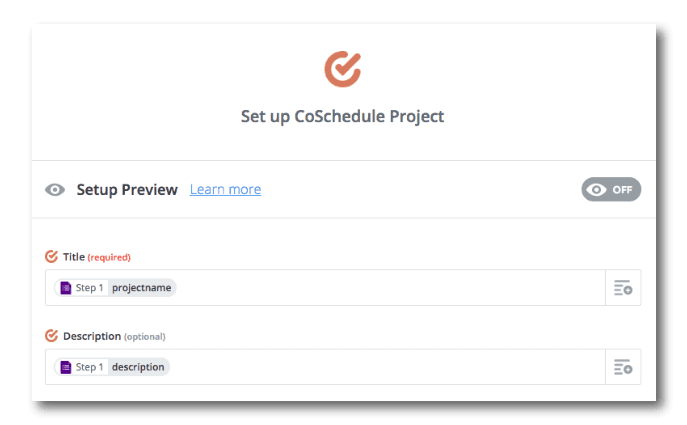 Choose Title: projectname and Description: description
Next, add more labels to project requests, choose a project type or color label.
Choose Title: projectname and Description: description
Next, add more labels to project requests, choose a project type or color label.
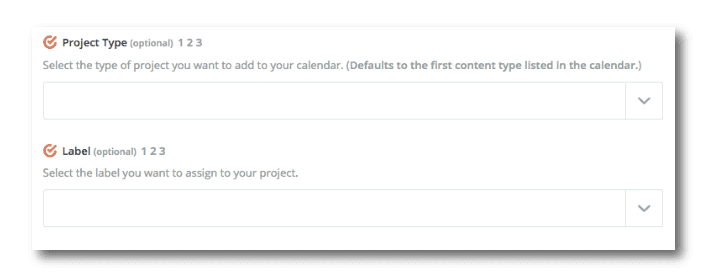 Finally, choose a Project Owner, Status, and whether or not you want the request to go to the Idea Board. Choosing an owner for all requests will notify a specific individual any time a new request is created.
If you don't want a marketing request to be automatically scheduled on your live calendar, you can send the requests directly to your Idea Board to manually schedule later based on team bandwidth.
Finally, choose a Project Owner, Status, and whether or not you want the request to go to the Idea Board. Choosing an owner for all requests will notify a specific individual any time a new request is created.
If you don't want a marketing request to be automatically scheduled on your live calendar, you can send the requests directly to your Idea Board to manually schedule later based on team bandwidth.
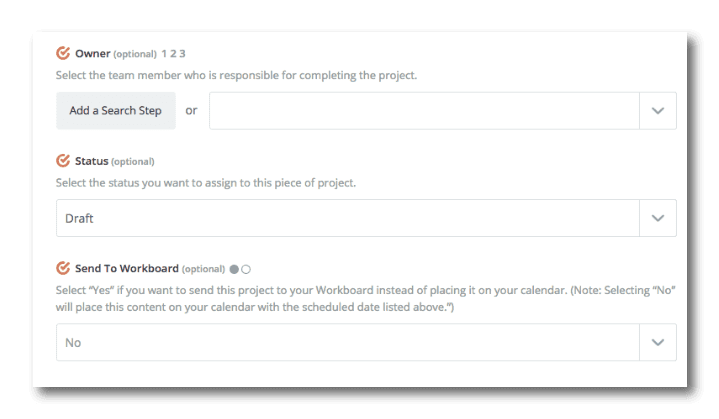 If you choose to have your marketing request go straight to the Idea Board, here's what it will look like.
If you choose to have your marketing request go straight to the Idea Board, here's what it will look like.
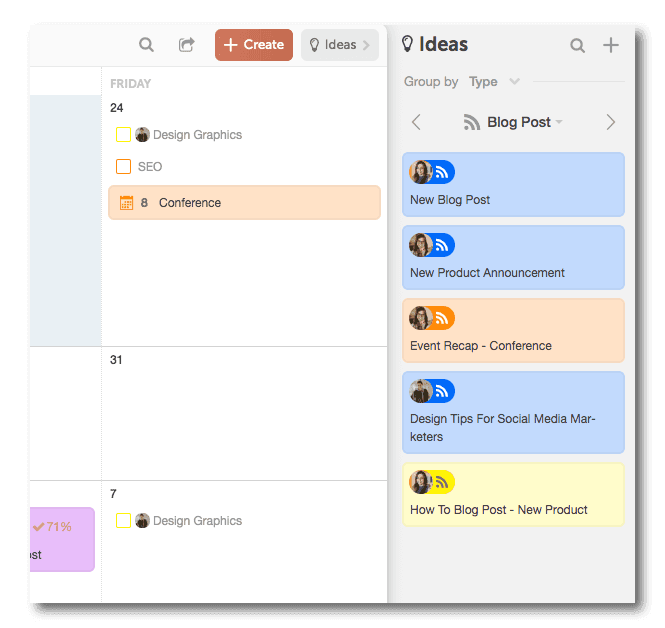 You can then drag and drop each request on to your calendar to schedule them based on your team's workload and content plan.
You can then drag and drop each request on to your calendar to schedule them based on your team's workload and content plan.

Conflict Resolution: How to Say No and Defend Your Team’s Time
The goal behind creating a marketing workflow management system is to protect your time against unreasonable last-minute requests. It forces your organization to respect your team’s time, while clearly communicating how long work will take. This sets up realistic expectations for everyone and cuts down on internal conflict. However, how do you handle disagreements if they do come up? Maybe HR doesn’t understand why you can’t create a recruiting brochure in two days. Or, perhaps your PR team is flustered because they need collateral for an event in a week, and need you to deliver it right now. You can always pass responsibility back where it belongs: with the team that didn’t plan ahead effectively. You’ll want to handle those conversations with care, though, and you don’t want to look like you’re unfriendly or process-driven to a fault, either. There are going to be times where changes in plans require some quick hustling, and you should be prepared to help (sometimes).Saying No Professionally and Politely
A lot of us hate saying no to projects. Unless you like constantly derailing your own priorities, though, it’s an essential skill to have.- Understand the need to protect your own time. We naturally want to help when we’re asked to do something. If diverting your attention away is going to result in your own work suffering, though, it might not always be worth it.
- Understand that you don’t have to get into the weeds explaining yourself. The person requesting your time probably doesn’t care exactly why you can’t help them right away. As long as you can explain you have important projects to complete, that should be enough (and will save time for both of you).
- If you can’t help, try to find someone who can. If there’s someone else in your organization who can help, refer the requester to the next best possible contact. They’ll appreciate your thoughtfulness and everyone will get more done.
#Productivity tip: learn how (and when) to say no.
Click To TweetWhat to Do When Legitimate Emergencies Arise
We’ve all been in a situation where a real crisis breaks out. It’s all hands on deck getting it resolved, and no one gets to go home until it’s taken care of. In these kinds of situations, use your best judgment. Don’t be a stickler about making people complete project requests. That’d be like calling the fire department to stop your house from burning down, and getting handed a form to complete first.Make Sure Your Team Isn’t Overloaded
So, you’ve set up your marketing workflow management system. But, what do you do if productivity isn’t actually going up? There could be a number of issues at play, but it could be that your team is still feeling overloaded. If that’s the case, here are some possible resolutions:- You need to hire more people. If your team needs some fresh faces and helping hands, let your HR or recruiting team know. Hiring too slowly can inhibit growth, and possibly lead to burnout. You don’t want to watch employees suffer or leave your company.
- You need to talk to your team about why their work isn’t getting done. It’s possible some people simply aren’t pulling their weight. Identify those issues and get them taken care of.
- You need to further refine your workflows. If there are any unnecessary steps in your processes you could remove, then cut them out of your workflows. Building efficiency into the way you work is a process and you might not nail it right away.
 You can also see individual stats for each team member.
You can also see individual stats for each team member.

It’s Time to Rethink Marketing Workflow Management
With the information and free templates in this post, you should have everything you need to stop surprise projects from driving down your team’s efficiency.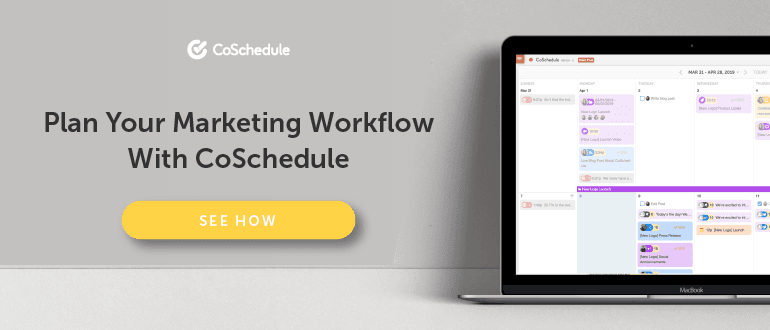 This post was originally published on January 24, 2018. It was updated and republished on June 20, 2019.
This post was originally published on January 24, 2018. It was updated and republished on June 20, 2019.

